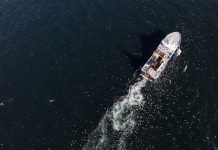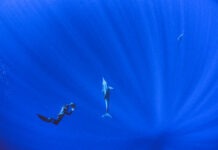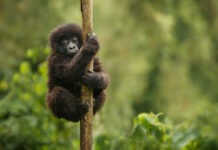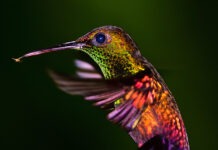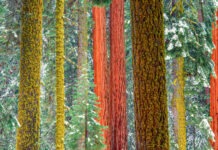
From 23rd April 2015, IMAX Darling Harbour will transport audiences into the mysterious underwater world of one of nature’s most awe-inspiring marine mammals in HUMPBACK WHALES 3D.
Narrated by Ewan McGregor, the film captures unparalleled footage of humpbacks for the first time with IMAX 3D cameras. Songs from the male humpbacks will fill the theatre while the majestic creatures appear life-size on the giant screen as they leap, twirl, lunge and splash.
Audiences will join a team of researchers as they unlock the secrets of the colossal humpback and find out what makes them the most acrobatic of all whales, why only the males sing, and why these intelligent 50-foot, 48-ton animals migrate more than 6,000 miles every year.
Curious to learn more about the challenges of filming and it’s charismatic cast of characters, I caught-up with the talented duo behind this epic new feature.
The director, two-time Academy Award®-nominated filmmaker Greg MacGillivray (The Living Sea, Dolphins) and producer, Shaun MacGillivray (To The Arctic, Journey to the South Pacific).
Questions about Humpback 3D
What made you choose Humpback whales as the subject of your next project?
We have made many ocean films but we had always wanted to do a film on humpback whales. We were lucky to finally find a fantastic partner in Pacific Life who helped us make this film a reality. Humpback whales are the perfect size and scale for an IMAX film, and the fact that they have such interesting behavior—they breach, sing, are playful and caring – make them the perfect subject for the giant screen.
What makes your film unique from other productions on the species?
It is the first film for IMAX theatres focused specifically on humpback whales. Audiences will be able to dive underwater with these whales and become immersed in their hidden world and experience them life-size on the giant screen. IMAX has the highest resolution capture in the world so it will be an amazing experience for audiences.
As a multi-award winning production company you clearly have discovered a formula audiences love, how would you define it?
Our mission is to harness the power of great storytelling and powerful imagery to take people to places they cannot typically go, to show them things they cannot otherwise see and let them experience things they have only imagined.
How do you adapt filming and direction when your key stars are 55ft, 50-ton aquatic mammals?
We use ultra wide angle lenses on our huge IMAX cameras so the camera can get close to them and you feel like you are right there swimming with them.
What were the challenges of production for this format (equipment/environment)?
There are a lot of challenges. Our equipment and gear is larger and heavier than any other film equipment. You only have 3 minutes per film load and then you have to reload back up on the boat. Each reel costs US $1,000 dollars per minute, so you want to make sure you get the right shot, and it can be very hard to find and film whales. You are on their schedule. In a month-long time period in Tonga, we had only one breathtakingly beautiful day with a mom and a calf who stayed with us for four hours.

How long did filming take and did this influence your bond or insight with the whales?
It was amazing to be face to face with a mother humpback and actually see her looking at you, with one of her large majestic eyes. In the film we have a great shot where you see her looking at the camera and you really feel like she is peering into your soul.
What are most fascinating aspects you discovered through the process?
It was fascinating to learn how much remains unknown about humpbacks and their world—and how dedicated these scientists are to their painstaking work. Humpbacks are very difficult to study because they spend so much of their time underwater.
Ewan McGregor lends his voice as the narrator—what made him the perfect candidate?
I have always loved Ewan as an actor, in fact one of my favorite films is Big Fish. He has an intelligence and a sophistication, and he was able to use his unique talent to add a real warmth to the film. He really becomes a main character in a way.
Is there a definitive message this film aims to impart?
This is an exciting, educational, fun adventure into the lives of a species that scientists still know very little about – in the end we want audiences to feel inspired and care a bit more about our oceans and this incredible animal.
Questions on MacFree and using IMAX to ‘Expand Our View’
How has nature and culture shaped your cinematic vision?
I was fortunate to grow up traveling to different cultures and locations around the world while being on film sets, and I think I appreciate our planet’s diversity, resiliency and natural wonder all the more, which we try to impart in our films. Our world is pretty freaking amazing, and we want audiences to discover, or rediscover, just how truly remarkable it is.
What are the essential elements of a great story?
Some elements that are key to our medium are powerful imagery, locations that take your breath away, and great characters that show us something unexpected. It takes a lot of time and research to find all the right elements, but when it all comes together it is magical.
How do you preserve these aspects when translating a story through film?
Through careful planning and preparation, then taking advantage of what comes your way on location.
Why is IMAX such a powerful way to communicate?
Because of the format’s high resolution, clarity and brightness, it immerses audiences in the scene like no other format. You feel like you are in the picture. It really rises above the clutter of everything else that we are bombarded with every day – for 40 minutes you are transported to a new place.
How have you expanded the cinema experience with outreach education?
We work with educators to create ancillary educational material, like educator guides and toolkits so students and families can dive much deeper in a hands-on way into the science and stories.
What is your most memorable encounter?
With Humpbacks it was definitely swimming face to face with a mother hHumpback – crazy and exhilarating.
Where is the most fascinating place you’ve filmed?
Tonga is up there. I would also say filming polar bears in Norway was pretty unreal as well.
Do you have a favourite film or one with personal resonance?
Right now Humpback Whales hands down!
How do you hope all your films are received?
We hope our films push the envelope of creativity while educating and inspiring people to travel, learn, and be more engaged with our world as a whole.
What’s next for MacGillivray Freeman Films?
We’re making a film about America’s national parks for the centennial in 2016, tentatively called America Wild: The National Parks.
Explore the World of MF: www.macgillivrayfreemanfilms.com
Watch films trailer: www.imax.com.au/films/humpback-whales-3d/videos.aspx
Buy tickets to HUMPBACK WHALES 3D: www.imax.com.au or PH: (02) 9213 1600





